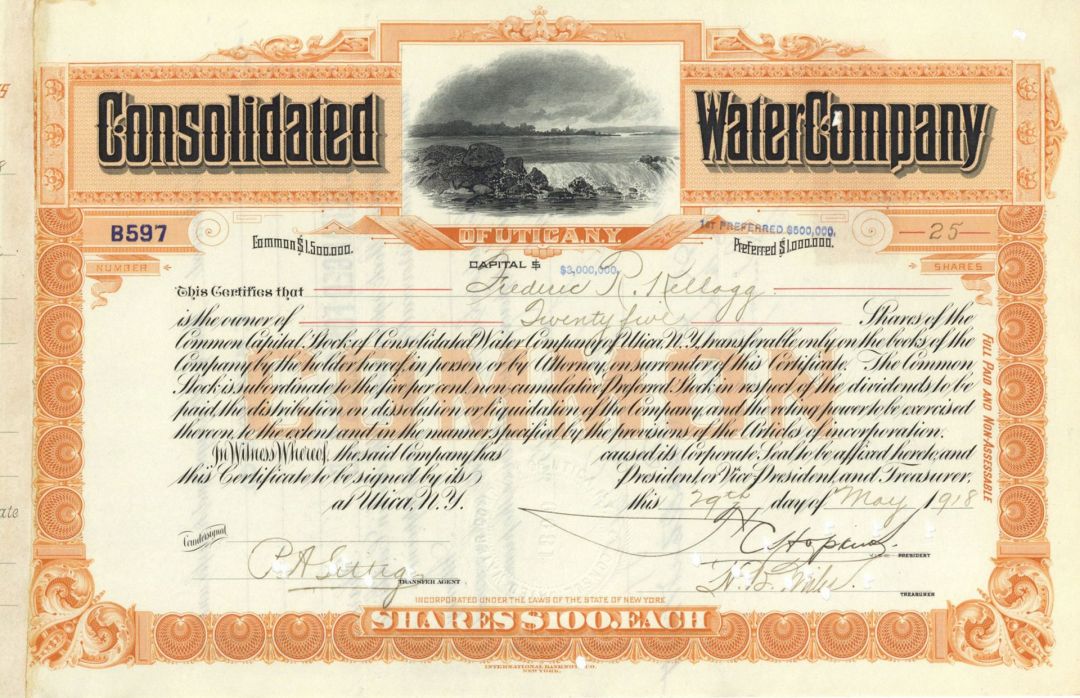Consolidated Water Co of Utica, N. Y. - Stock Certificate
Inv# GS1091 StockUtica was established on the site of Old Fort Schuyler, built by American colonists for defense in 1758 during the French and Indian War, the North American front of the Seven Years' War against France. Prior to construction of the fort, the Mohawk, Onondaga and Oneida tribes had occupied this area south of the Great Lakes region as early as 4000 BC. The Mohawk were the largest and most powerful tribe in the eastern part of the Mohawk Valley. American colonists had a longstanding fur trade with them, in exchange for firearms and rum. The tribe's dominating presence in the region prevented the Province of New York from expanding past the middle of the Mohawk Valley until after the American victory in the Revolutionary War, when the British-allied Iroquois were forced to cede their lands as allies of the defeated British, and the American-allied Iroquois were forced to cede land in exchange for shelter and supplies following brutal fighting.
The land housing Old Fort Schuyler was part of a 20,000-acre (81 km2) portion of marshland granted by King George II to New York governor William Cosby on January 2, 1734. Since the fort was located near several trails (including the Great Indian Warpath), its position—on a bend at a shallow portion of the Mohawk River—made it an important fording point. The Mohawk called the bend Unundadages ("around the hill"), and the Mohawk word appears on the city's seal.
During the American Revolutionary War, border raids from British-allied Iroquois tribes harried the settlers on the frontier. George Washington ordered Sullivan's Expedition, Rangers, to enter Central New York and suppress the Iroquois threat. More than 40 Iroquois villages were destroyed and their winter stores, causing starvation. In the aftermath of the war, numerous European-American settlers migrated into the state and this western region from New England, especially Connecticut.
In 1794 a state road, Genesee Road, was built from Utica west to the Genesee River. That year a contract was awarded to the Mohawk Turnpike and Bridge Company to extend the road northeast to Albany, and in 1798 it was extended. The Seneca Turnpike was key to Utica's development, replacing a worn footpath with a paved road. The village became a rest and supply area along the Mohawk River for goods and the many people moving through Western New York to and from the Great Lakes.
The boundaries of the village of Utica were defined in an act passed by the New York State Legislature on April 3, 1798. Utica expanded its borders in subsequent 1805 and 1817 charters. On April 5, 1805, the village's eastern and western boundaries were expanded, and on April 7, 1817, Utica separated from Whitestown on its west. After completion of the Erie Canal in 1825, the city's growth was stimulated again.
The municipal charter was passed by the state legislature on February 13, 1832. In 1845 the United States Census ranked Utica as the 29th-largest in the country (with 20,000 residents, more than the populations of Chicago, Detroit or Cleveland.
A stock certificate is issued by businesses, usually companies. A stock is part of the permanent finance of a business. Normally, they are never repaid, and the investor can recover his/her money only by selling to another investor. Most stocks, or also called shares, earn dividends, at the business's discretion, depending on how well it has traded. A stockholder or shareholder is a part-owner of the business that issued the stock certificates.











Ebay ID: labarre_galleries